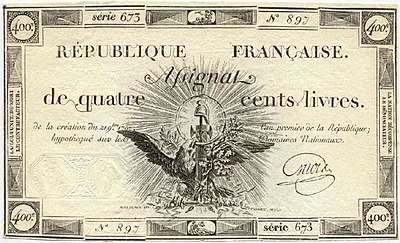Biens nationaux
This article includes alist of references,related reading,orexternal links,but its sources remain unclear because it lacksinline citations.(April 2020) |

Thebiens nationauxwerepropertiesconfiscatedduring theFrench Revolutionfrom theCatholic Church,themonarchy,émigrés,and suspectedcounter-revolutionariesfor "the good of the nation".
Biensmeans "goods", both in the sense of "objects" and in the sense of "benefits".Nationauxmeans "of the nation". This can be summarized as "things for the good of the nation", or simply "national goods".
The possessions of theRoman Catholic Churchwere declared national property by thedecree of 2 November 1789.These were sold to resolve thefinancial crisisthat caused the Revolution. Later, the properties ofthe Crownwere given the same treatment.
The concept of national property was later extended to the property of theémigrés,and the suspected counter-revolutionaries, which were confiscated from 30 March 1792, and sold after the decree of 27 July.
Confiscation of the goods of the clergy[edit]
A few months into the Revolution, the public purse was all but empty. To amend this fiscal problem, the deputyTalleyrandproposed nationalizing the goods of the clergy. Pursuing the proposal, on 2 November 1789, theAssemblée Nationalevoted that all the goods of the clergy "will be placed at the disposal of the nation", declared to be henceforthbiens nationaux,national goods, to be put out to bid at auction on behalf of the State.
New currency[edit]

This legacy, evaluated to just about 3 billionlivres,constituted a substantial improvement for public finance. The disposition of these goods was entrusted to a special office, calledla Caisse de l'Extraordinaire,which was formed on 19 December 1789.
The difficulty was that the sale of so manybienswould take time, at least a year, while thecaissesof the State were empty and national bankruptcy appeared to be immediate. Therefore, it was decided to produce, the very same day as the creation ofla Caisse de l'Extraordinaire,a type of bonds calledassignats.The value of these bills or bonds was based on the estimated value of the clerical properties. Theassignatswere issued by the National Constituent Assembly.
Initially meant as bonds, theassignatsdeveloped into a paper currency used aslegal tender.
Inflation[edit]
As there was no control over the amount to be printed, the value of theassignatswent beyond the limits of the confiscated properties. This causedhyperinflation.In the beginning of 1792, they had lost most of their supposed value.
This hyperinflation was inspired by continual food shortages. Rather than solving the financial problems, theassignatsbecame a cause for food riots. Insecurity continued after the abolition of the monarchy, and the situation got worse with the wars France faced. These circumstances interfered with the completion of good financial policies that would reduce debts. Bills were passed such as theMaximum Price Act(loi du maximum général) of 1793, meant to control price increases.
On 28 December 1793, the Assembly issued the legislation to confiscate the property of individuals regarded as enemies of the Revolution, which included the émigrés and fugitives, hostile priesthood, the deportees, prisoners, those sentenced to death, and the aliens from enemy countries.
When theDirectoirecame into power in 1795 the Maximum Price Act was lifted. Highmonetary inflationreemerged and in the next four years Paris was the scene of yet more riots. Theassignatswere becoming worthless.
France's financial problems were solved during theFrench ConsulatewhenNapoleon,the First Consul, created the country's new currency, thefranc germinal,by the law of 28 March 1803 (loi du 7 Germinal an XI).
See also[edit]
Notes[edit]
- Based on French Wikipedia.
